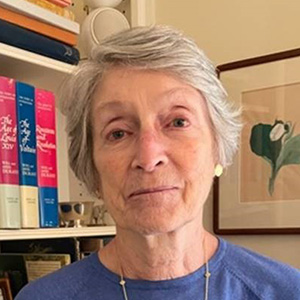Ann Dean, Ph.D.

Professional Experience
- Ph.D., The George Washington University, 1981
- B.A., Bucknell University, 1966
Research Goal
The goal of these studies is to understand how cell-specific transcriptomes that define the differentiated tissues of an organism arise from the same genetic blueprint—the genome.
Current Research
How complex organisms with diverse tissue and cell types can arise from the same genome is one of the most enuring and fascinating questions in biology. We study enhancers, which are cis-acting DNA sequences that increase the transcriptional output of genes and, in so doing, orchestrate the cell specific transcriptomes that underlie development and differentiation. We are interested in the mechanisms that underlie formation of long range interactions between distant enhancers and target genes, how they influence and are influenced by overall chromosome folding and how enhancers change gene expression programs. Our studies focus on the family of β-globin genes, and erythroid genes more broadly, as a model system.
We are defining a complex of proteins including Ldb1/Lmo2/Tal1/Gata1 that mediates long range enhancer activation of essentially all erythroid genes. We are investigating the proteins the Ldb1 complex partners with to function in chromatin looping. We are also interested in the functional impact on gene expression of overall chromosome folding in the nucleus, which is thought to depend on architectural factors such as CTCF and cohesin.
To study long range enhancer-gene interactions, epigenetic histone modification and transcription regulation in mammalian cells, we use biochemistry, molecular biology, genetics and genomics. We deploy ChIP, ChIP-seq, RNA-seq and Chromosome Conformation Capture (3C)-related approaches and bioinformatic analysis, as well as RNA and DNA fluorescent in situ hybridization. Our experimental systems include (1) human and mouse erythroid cell lines, primary cells and mouse ES cells, (2) human β-globin YAC transgenic mice, and (3) mice with alterations in endogenous loci that we have targeted through homologous recombination or CRISPR/Cas9 genome editing.
Applying our Research
Our studies have contributed to showing that modulation of long range enhancer looping can reactivate the silent γ-globin gene in adult erythroid cells, which is a novel approach to treatment of sickle cell disease and β-thalassemia. Moreover, a major appreciation over the last few years is that mutations in enhancers that affect long range gene activation play a major role in mis-regulation of genes and contribute to genetic diseases and cancers. Thus, understanding how chromatin interactions are regulated during development and differentiation may offer insights into the treatment of numerous diseases.
Select Publications
- Long noncoding RNA GATA2AS influences human erythropoiesis by transcription factor and chromatin landscape modulation.
- Liu G, Kim J, Nguyen N, Zhou L, Dean A.
- Blood (2024 May 30) 143:2300-2313. Abstract/Full Text
- An enhancer RNA recruits KMT2A to regulate transcription of Myb.
- Kim J, Diaz LF, Miller MJ, Leadem B, Krivega I, Dean A.
- Cell Rep (2024 Jul 23) 43:114378. Abstract/Full Text
Research in Plain Language
Our laboratory studies how enhancers, which are short regions of DNA that can be bound with proteins, activate a process called transcription—the transfer of genetic information from DNA to RNA. We study how transcription is activated during development when less specialized cells become more specialized cell types. More specifically, we focus on the role played by chromatin structure in this process. Chromatin structure is the combination of DNA and proteins in the cell nucleus. The goal of these studies is to understand the complex interplay between nuclear genes and their modulators.
We conduct studies that focus on the family of human β-globin genes that code for the components of the blood protein, hemoglobin. Different hemoglobins are synthesized in mammalian embryos and adults, but all of them depend on an enhancer (called the locus control region, or LCR) to activate their transcription. We are trying to understand the role of specific proteins required for the start of transcription of the β-globin genes. In other studies, we look at the extent to which the physical proximity (chromosome looping) between the β-globin LCR and genes plays a role in transcription activation.

